turn signal CHRYSLER VOYAGER 1996 Owner's Manual
[x] Cancel search | Manufacturer: CHRYSLER, Model Year: 1996, Model line: VOYAGER, Model: CHRYSLER VOYAGER 1996Pages: 1938, PDF Size: 55.84 MB
Page 442 of 1938
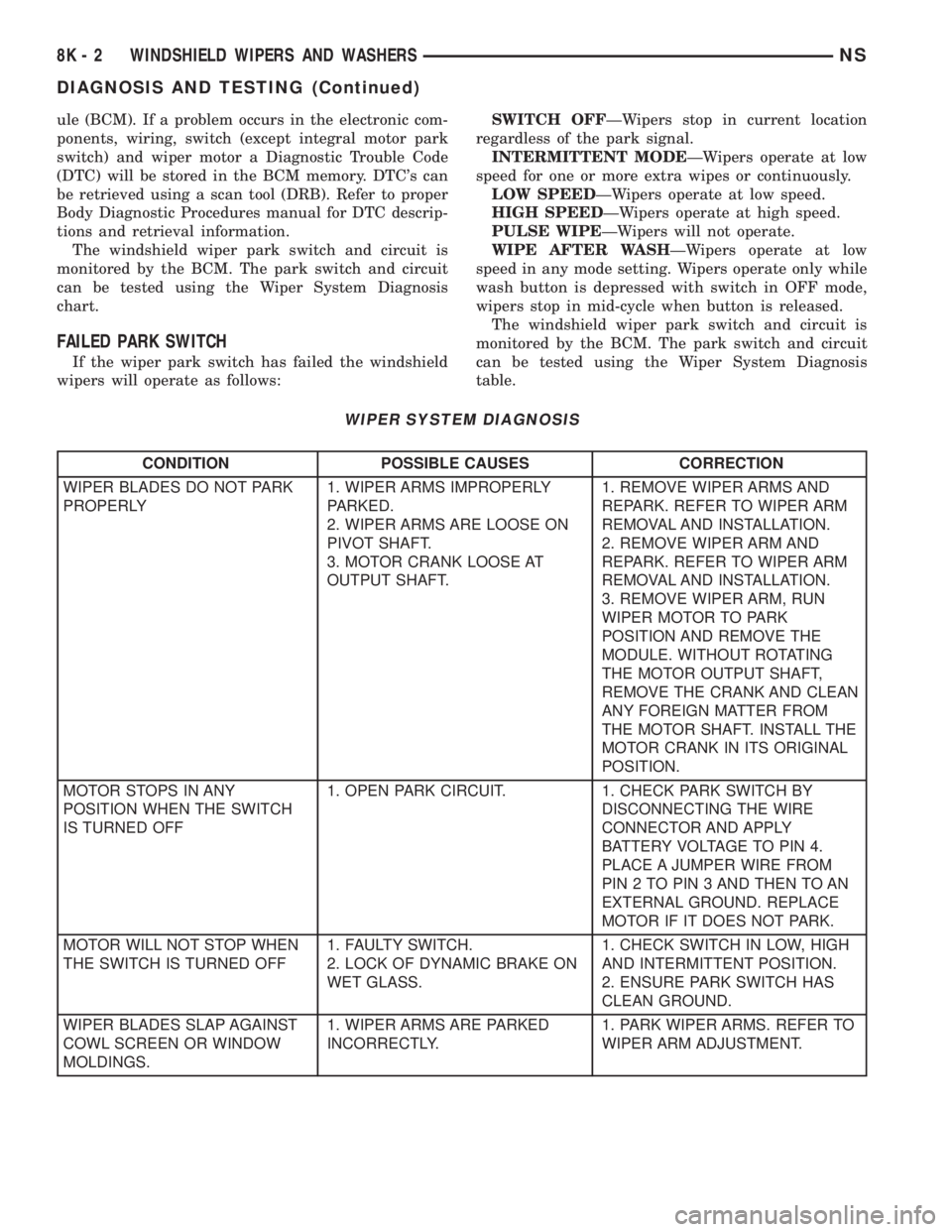
ule (BCM). If a problem occurs in the electronic com-
ponents, wiring, switch (except integral motor park
switch) and wiper motor a Diagnostic Trouble Code
(DTC) will be stored in the BCM memory. DTC's can
be retrieved using a scan tool (DRB). Refer to proper
Body Diagnostic Procedures manual for DTC descrip-
tions and retrieval information.
The windshield wiper park switch and circuit is
monitored by the BCM. The park switch and circuit
can be tested using the Wiper System Diagnosis
chart.
FAILED PARK SWITCH
If the wiper park switch has failed the windshield
wipers will operate as follows:SWITCH OFFÐWipers stop in current location
regardless of the park signal.
INTERMITTENT MODEÐWipers operate at low
speed for one or more extra wipes or continuously.
LOW SPEEDÐWipers operate at low speed.
HIGH SPEEDÐWipers operate at high speed.
PULSE WIPEÐWipers will not operate.
WIPE AFTER WASHÐWipers operate at low
speed in any mode setting. Wipers operate only while
wash button is depressed with switch in OFF mode,
wipers stop in mid-cycle when button is released.
The windshield wiper park switch and circuit is
monitored by the BCM. The park switch and circuit
can be tested using the Wiper System Diagnosis
table.
WIPER SYSTEM DIAGNOSIS
CONDITION POSSIBLE CAUSES CORRECTION
WIPER BLADES DO NOT PARK
PROPERLY1. WIPER ARMS IMPROPERLY
PARKED.
2. WIPER ARMS ARE LOOSE ON
PIVOT SHAFT.
3. MOTOR CRANK LOOSE AT
OUTPUT SHAFT.1. REMOVE WIPER ARMS AND
REPARK. REFER TO WIPER ARM
REMOVAL AND INSTALLATION.
2. REMOVE WIPER ARM AND
REPARK. REFER TO WIPER ARM
REMOVAL AND INSTALLATION.
3. REMOVE WIPER ARM, RUN
WIPER MOTOR TO PARK
POSITION AND REMOVE THE
MODULE. WITHOUT ROTATING
THE MOTOR OUTPUT SHAFT,
REMOVE THE CRANK AND CLEAN
ANY FOREIGN MATTER FROM
THE MOTOR SHAFT. INSTALL THE
MOTOR CRANK IN ITS ORIGINAL
POSITION.
MOTOR STOPS IN ANY
POSITION WHEN THE SWITCH
IS TURNED OFF1. OPEN PARK CIRCUIT. 1. CHECK PARK SWITCH BY
DISCONNECTING THE WIRE
CONNECTOR AND APPLY
BATTERY VOLTAGE TO PIN 4.
PLACE A JUMPER WIRE FROM
PIN 2 TO PIN 3 AND THEN TO AN
EXTERNAL GROUND. REPLACE
MOTOR IF IT DOES NOT PARK.
MOTOR WILL NOT STOP WHEN
THE SWITCH IS TURNED OFF1. FAULTY SWITCH.
2. LOCK OF DYNAMIC BRAKE ON
WET GLASS.1. CHECK SWITCH IN LOW, HIGH
AND INTERMITTENT POSITION.
2. ENSURE PARK SWITCH HAS
CLEAN GROUND.
WIPER BLADES SLAP AGAINST
COWL SCREEN OR WINDOW
MOLDINGS.1. WIPER ARMS ARE PARKED
INCORRECTLY.1. PARK WIPER ARMS. REFER TO
WIPER ARM ADJUSTMENT.
8K - 2 WINDSHIELD WIPERS AND WASHERSNS
DIAGNOSIS AND TESTING (Continued)
Page 444 of 1938
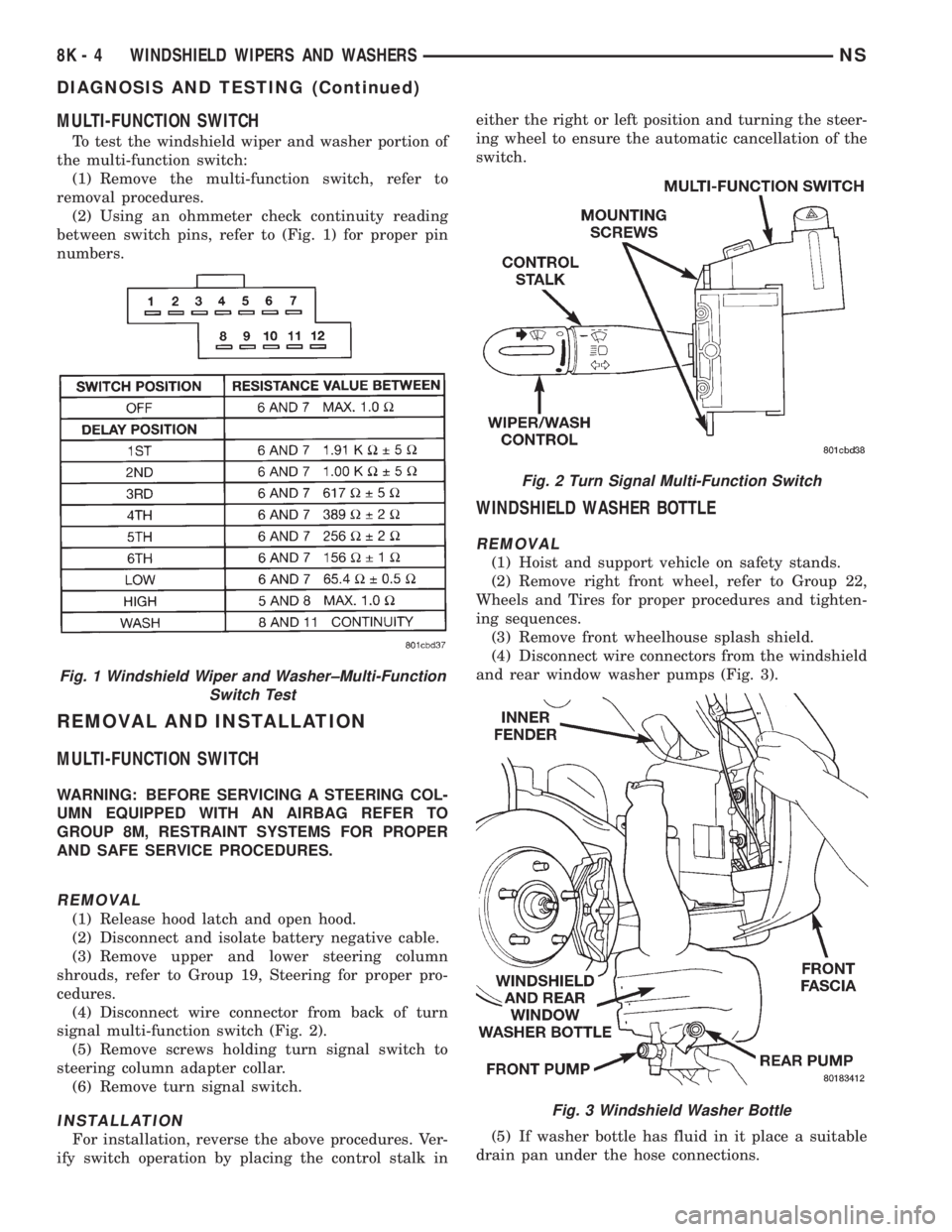
MULTI-FUNCTION SWITCH
To test the windshield wiper and washer portion of
the multi-function switch:
(1) Remove the multi-function switch, refer to
removal procedures.
(2) Using an ohmmeter check continuity reading
between switch pins, refer to (Fig. 1) for proper pin
numbers.
REMOVAL AND INSTALLATION
MULTI-FUNCTION SWITCH
WARNING: BEFORE SERVICING A STEERING COL-
UMN EQUIPPED WITH AN AIRBAG REFER TO
GROUP 8M, RESTRAINT SYSTEMS FOR PROPER
AND SAFE SERVICE PROCEDURES.
REMOVAL
(1) Release hood latch and open hood.
(2) Disconnect and isolate battery negative cable.
(3) Remove upper and lower steering column
shrouds, refer to Group 19, Steering for proper pro-
cedures.
(4) Disconnect wire connector from back of turn
signal multi-function switch (Fig. 2).
(5) Remove screws holding turn signal switch to
steering column adapter collar.
(6) Remove turn signal switch.
INSTALLATION
For installation, reverse the above procedures. Ver-
ify switch operation by placing the control stalk ineither the right or left position and turning the steer-
ing wheel to ensure the automatic cancellation of the
switch.
WINDSHIELD WASHER BOTTLE
REMOVAL
(1) Hoist and support vehicle on safety stands.
(2) Remove right front wheel, refer to Group 22,
Wheels and Tires for proper procedures and tighten-
ing sequences.
(3) Remove front wheelhouse splash shield.
(4) Disconnect wire connectors from the windshield
and rear window washer pumps (Fig. 3).
(5) If washer bottle has fluid in it place a suitable
drain pan under the hose connections.
Fig. 1 Windshield Wiper and Washer±Multi-Function
Switch Test
Fig. 2 Turn Signal Multi-Function Switch
Fig. 3 Windshield Washer Bottle
8K - 4 WINDSHIELD WIPERS AND WASHERSNS
DIAGNOSIS AND TESTING (Continued)
Page 453 of 1938

LAMPS
CONTENTS
page page
BULB APPLICATION...................... 25
EXTERIOR LAMP BULB SERVICE............ 9
EXTERIOR LAMP SERVICE................. 14HEADLAMP ALIGNMENT................... 5
INTERIOR LAMPS........................ 18
LAMP DIAGNOSIS........................ 1
LAMP DIAGNOSIS
INDEX
page page
GENERAL INFORMATION
ELECTRONIC DAYTIME RUNNING LIGHT (DRL).1
GENERAL INFORMATION.................. 1SAFETY PRECAUTIONS................... 1
DIAGNOSIS AND TESTING
DIAGNOSTIC PROCEDURES................ 2
GENERAL INFORMATION
GENERAL INFORMATION
NS vehicles use lighting on the interior and exte-
rior of the vehicle for illuminating and indicating
purposes. Lighting circuits are protected by fuses.
Lighting circuits require an overload protected power
source, on/off device, lamps and body ground to oper-
ate properly. Plastic lamps require a wire in the har-
ness to supply body ground to the lamp socket.
Replace sockets and bulbs that are corroded.
Some of the interior and exterior lighting functions
are governed by the body controller. The headlamp,
dome, and the door ajar switches provide signals to
the body controller. The body controller in turn acti-
vates relay(s) in order to provide either a ground or
feed line to the appropriate lamp(s).
Wire connectors can make intermittent contact or
become corroded. Before coupling wire connectors,
inspect the terminals inside the connector. Male ter-
minals should not be bent or disengaged from the
insulator. Female terminals should not be sprung
open or disengaged from the insulator. Bent and
sprung terminals can be repaired using needle nose
pliers and pick tool. Corroded terminals appear
chalky or green. Corroded terminals should be
replaced to avoid recurrence of the problem symp-
toms.
Begin electrical system failure diagnosis by testing
related fuses in the fuse block and power distribution
center. Verify that bulbs are in good condition andtest continuity of the circuit ground. Refer to Group
8W, Wiring Diagrams, for component location and cir-
cuit information.SAFETY PRECAUTIONS
WARNING: EYE PROTECTION SHOULD BE USED
WHEN SERVICING GLASS COMPONENTS. PER-
SONAL INJURY CAN RESULT.
CAUTION: Do not touch the glass of halogen bulbs
with fingers or other possibly oily surface, reduced
bulb life will result.
Do not use bulbs with higher candle power than
indicated in the Bulb Application table at the end of
this group. Damage to lamp and/or Daytime Run-
ning Lamp Module can result.
Do not use fuses, circuit breakers or relays hav-
ing greater amperage value than indicated on the
fuse panel or in the Owners Manual.
When it is necessary to remove components to ser-
vice another, it should not be necessary to apply
excessive force or bend a component to remove it.
Before damaging a trim component, verify hidden
fasteners or captured edges are not holding the com-
ponent in place.
ELECTRONIC DAYTIME RUNNING LIGHT (DRL)
The Combination Flasher/DRL is a module provid-
ing turn signal, hazard warning, and daytime run-
NSLAMPS 8L - 1
Page 454 of 1938

ning light functions (for Canadian vehicles), and has
been designed with internal relays to take advantage
of low current switching requirements in the vehicle.
It is plugged into the junction block at positions
three and four (Fig. 1), where all wiring associated
with its operation is terminated. The junction block
is adjacent to and left of the steering column of the
vehicle. For diagnostic information refer to Group 8J,
Turn Signal and Flashers.
On vehicles built for use in the United States, only
position four is used. Vehicles built for use in Canada
utilize both positions three and four.
To gain access to the device, remove the lower
steering column cover and knee blocker. Refer to
Group 8E, Instrument Panel and Gauges.SYSTEM FUNCTION
The combination-flasher/DRL may be operated in
its hazard warning mode either with or without the
ignition circuit being active. However, in order to
operate in the turn signal mode or the DRL mode,
the ignition circuit must be completed to the module.
While the combination-flasher portion is idle, there
is no current drawn through the module. The device
does not become active in the turn signal or hazard
warning modes until a signal ground circuit is sup-
plied to either of the turn signal inputs or the hazard
warning input. With the ignition OFF, there is no
current drawn through the module.
While the ignition is ON, the front turn signal fil-
aments are illuminated steadily thus providing the
DRL function. The DRL function may be inhibited by
applying a signal ground input from either the park
brake circuit or the headlamp relay activation circuit.
DIAGNOSIS AND TESTING
DIAGNOSTIC PROCEDURES
When a vehicle experiences problems with the
headlamp system, verify the condition of the battery
connections, charging system, headlamp bulbs, wire
connectors, relay, high beam dimmer switch and
headlamp switch. Refer to Group 8W, Wiring Dia-
grams, for component locations and circuit informa-
tion.
Fig. 1 Junction Block Terminal PINS
8L - 2 LAMPSNS
GENERAL INFORMATION (Continued)
Page 461 of 1938
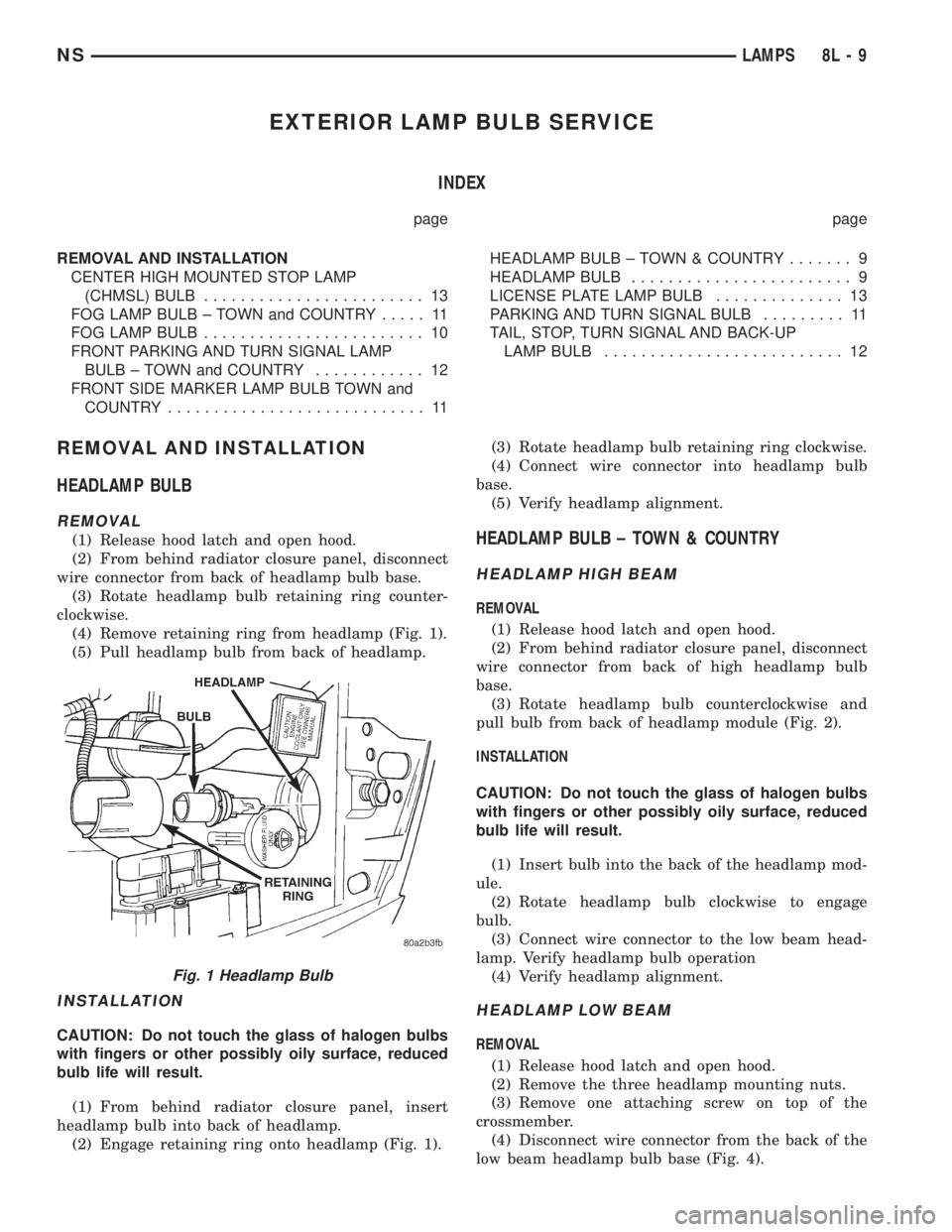
EXTERIOR LAMP BULB SERVICE
INDEX
page page
REMOVAL AND INSTALLATION
CENTER HIGH MOUNTED STOP LAMP
(CHMSL) BULB........................ 13
FOG LAMP BULB ± TOWN and COUNTRY..... 11
FOG LAMP BULB........................ 10
FRONT PARKING AND TURN SIGNAL LAMP
BULB ± TOWN and COUNTRY............ 12
FRONT SIDE MARKER LAMP BULB TOWN and
COUNTRY............................ 11HEADLAMP BULB ± TOWN & COUNTRY....... 9
HEADLAMP BULB........................ 9
LICENSE PLATE LAMP BULB.............. 13
PARKING AND TURN SIGNAL BULB......... 11
TAIL, STOP, TURN SIGNAL AND BACK-UP
LAMP BULB.......................... 12
REMOVAL AND INSTALLATION
HEADLAMP BULB
REMOVAL
(1) Release hood latch and open hood.
(2) From behind radiator closure panel, disconnect
wire connector from back of headlamp bulb base.
(3) Rotate headlamp bulb retaining ring counter-
clockwise.
(4) Remove retaining ring from headlamp (Fig. 1).
(5) Pull headlamp bulb from back of headlamp.
INSTALLATION
CAUTION: Do not touch the glass of halogen bulbs
with fingers or other possibly oily surface, reduced
bulb life will result.
(1) From behind radiator closure panel, insert
headlamp bulb into back of headlamp.
(2) Engage retaining ring onto headlamp (Fig. 1).(3) Rotate headlamp bulb retaining ring clockwise.
(4) Connect wire connector into headlamp bulb
base.
(5) Verify headlamp alignment.
HEADLAMP BULB ± TOWN & COUNTRY
HEADLAMP HIGH BEAM
REMOVAL
(1) Release hood latch and open hood.
(2) From behind radiator closure panel, disconnect
wire connector from back of high headlamp bulb
base.
(3) Rotate headlamp bulb counterclockwise and
pull bulb from back of headlamp module (Fig. 2).
INSTALLATION
CAUTION: Do not touch the glass of halogen bulbs
with fingers or other possibly oily surface, reduced
bulb life will result.
(1) Insert bulb into the back of the headlamp mod-
ule.
(2) Rotate headlamp bulb clockwise to engage
bulb.
(3) Connect wire connector to the low beam head-
lamp. Verify headlamp bulb operation
(4) Verify headlamp alignment.
HEADLAMP LOW BEAM
REMOVAL
(1) Release hood latch and open hood.
(2) Remove the three headlamp mounting nuts.
(3) Remove one attaching screw on top of the
crossmember.
(4) Disconnect wire connector from the back of the
low beam headlamp bulb base (Fig. 4).
Fig. 1 Headlamp Bulb
NSLAMPS 8L - 9
Page 463 of 1938
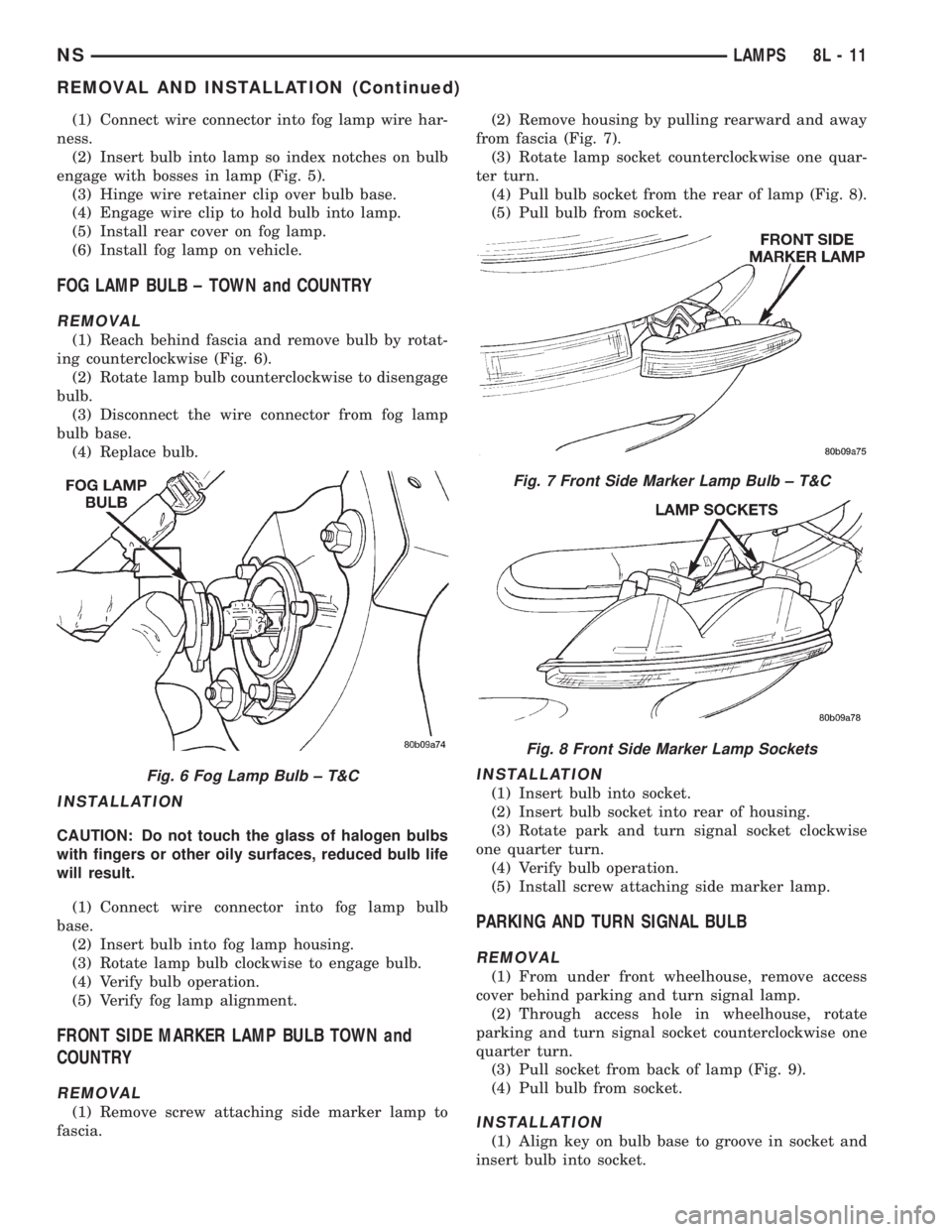
(1) Connect wire connector into fog lamp wire har-
ness.
(2) Insert bulb into lamp so index notches on bulb
engage with bosses in lamp (Fig. 5).
(3) Hinge wire retainer clip over bulb base.
(4) Engage wire clip to hold bulb into lamp.
(5) Install rear cover on fog lamp.
(6) Install fog lamp on vehicle.
FOG LAMP BULB ± TOWN and COUNTRY
REMOVAL
(1) Reach behind fascia and remove bulb by rotat-
ing counterclockwise (Fig. 6).
(2) Rotate lamp bulb counterclockwise to disengage
bulb.
(3) Disconnect the wire connector from fog lamp
bulb base.
(4) Replace bulb.
INSTALLATION
CAUTION: Do not touch the glass of halogen bulbs
with fingers or other oily surfaces, reduced bulb life
will result.
(1) Connect wire connector into fog lamp bulb
base.
(2) Insert bulb into fog lamp housing.
(3) Rotate lamp bulb clockwise to engage bulb.
(4) Verify bulb operation.
(5) Verify fog lamp alignment.
FRONT SIDE MARKER LAMP BULB TOWN and
COUNTRY
REMOVAL
(1) Remove screw attaching side marker lamp to
fascia.(2) Remove housing by pulling rearward and away
from fascia (Fig. 7).
(3) Rotate lamp socket counterclockwise one quar-
ter turn.
(4) Pull bulb socket from the rear of lamp (Fig. 8).
(5) Pull bulb from socket.
INSTALLATION
(1) Insert bulb into socket.
(2) Insert bulb socket into rear of housing.
(3) Rotate park and turn signal socket clockwise
one quarter turn.
(4) Verify bulb operation.
(5) Install screw attaching side marker lamp.
PARKING AND TURN SIGNAL BULB
REMOVAL
(1) From under front wheelhouse, remove access
cover behind parking and turn signal lamp.
(2) Through access hole in wheelhouse, rotate
parking and turn signal socket counterclockwise one
quarter turn.
(3) Pull socket from back of lamp (Fig. 9).
(4) Pull bulb from socket.
INSTALLATION
(1) Align key on bulb base to groove in socket and
insert bulb into socket.
Fig. 6 Fog Lamp Bulb ± T&C
Fig. 7 Front Side Marker Lamp Bulb ± T&C
Fig. 8 Front Side Marker Lamp Sockets
NSLAMPS 8L - 11
REMOVAL AND INSTALLATION (Continued)
Page 464 of 1938
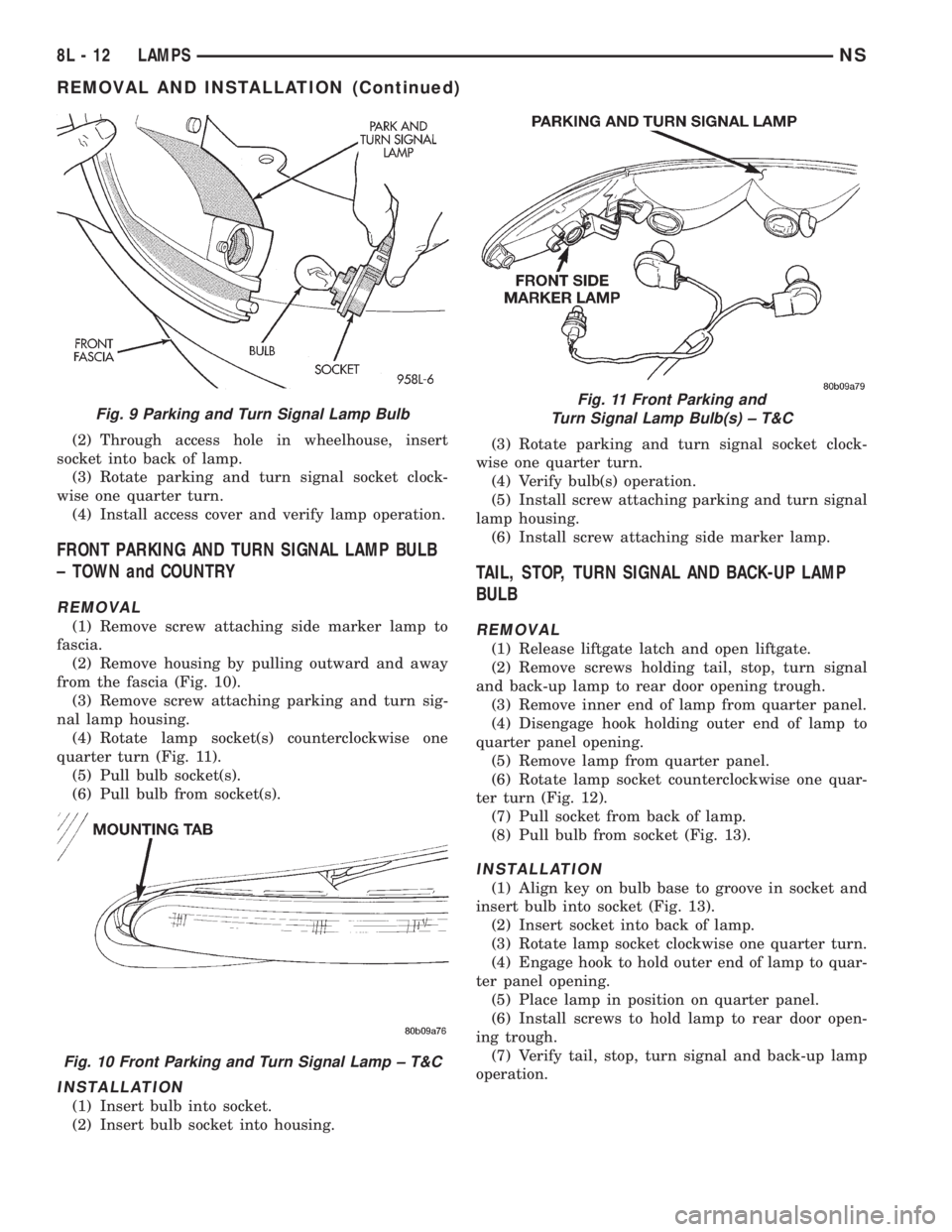
(2) Through access hole in wheelhouse, insert
socket into back of lamp.
(3) Rotate parking and turn signal socket clock-
wise one quarter turn.
(4) Install access cover and verify lamp operation.
FRONT PARKING AND TURN SIGNAL LAMP BULB
± TOWN and COUNTRY
REMOVAL
(1) Remove screw attaching side marker lamp to
fascia.
(2) Remove housing by pulling outward and away
from the fascia (Fig. 10).
(3) Remove screw attaching parking and turn sig-
nal lamp housing.
(4) Rotate lamp socket(s) counterclockwise one
quarter turn (Fig. 11).
(5) Pull bulb socket(s).
(6) Pull bulb from socket(s).
INSTALLATION
(1) Insert bulb into socket.
(2) Insert bulb socket into housing.(3) Rotate parking and turn signal socket clock-
wise one quarter turn.
(4) Verify bulb(s) operation.
(5) Install screw attaching parking and turn signal
lamp housing.
(6) Install screw attaching side marker lamp.
TAIL, STOP, TURN SIGNAL AND BACK-UP LAMP
BULB
REMOVAL
(1) Release liftgate latch and open liftgate.
(2) Remove screws holding tail, stop, turn signal
and back-up lamp to rear door opening trough.
(3) Remove inner end of lamp from quarter panel.
(4) Disengage hook holding outer end of lamp to
quarter panel opening.
(5) Remove lamp from quarter panel.
(6) Rotate lamp socket counterclockwise one quar-
ter turn (Fig. 12).
(7) Pull socket from back of lamp.
(8) Pull bulb from socket (Fig. 13).
INSTALLATION
(1) Align key on bulb base to groove in socket and
insert bulb into socket (Fig. 13).
(2) Insert socket into back of lamp.
(3) Rotate lamp socket clockwise one quarter turn.
(4) Engage hook to hold outer end of lamp to quar-
ter panel opening.
(5) Place lamp in position on quarter panel.
(6) Install screws to hold lamp to rear door open-
ing trough.
(7) Verify tail, stop, turn signal and back-up lamp
operation.
Fig. 9 Parking and Turn Signal Lamp Bulb
Fig. 10 Front Parking and Turn Signal Lamp ± T&C
Fig. 11 Front Parking and
Turn Signal Lamp Bulb(s) ± T&C
8L - 12 LAMPSNS
REMOVAL AND INSTALLATION (Continued)
Page 465 of 1938
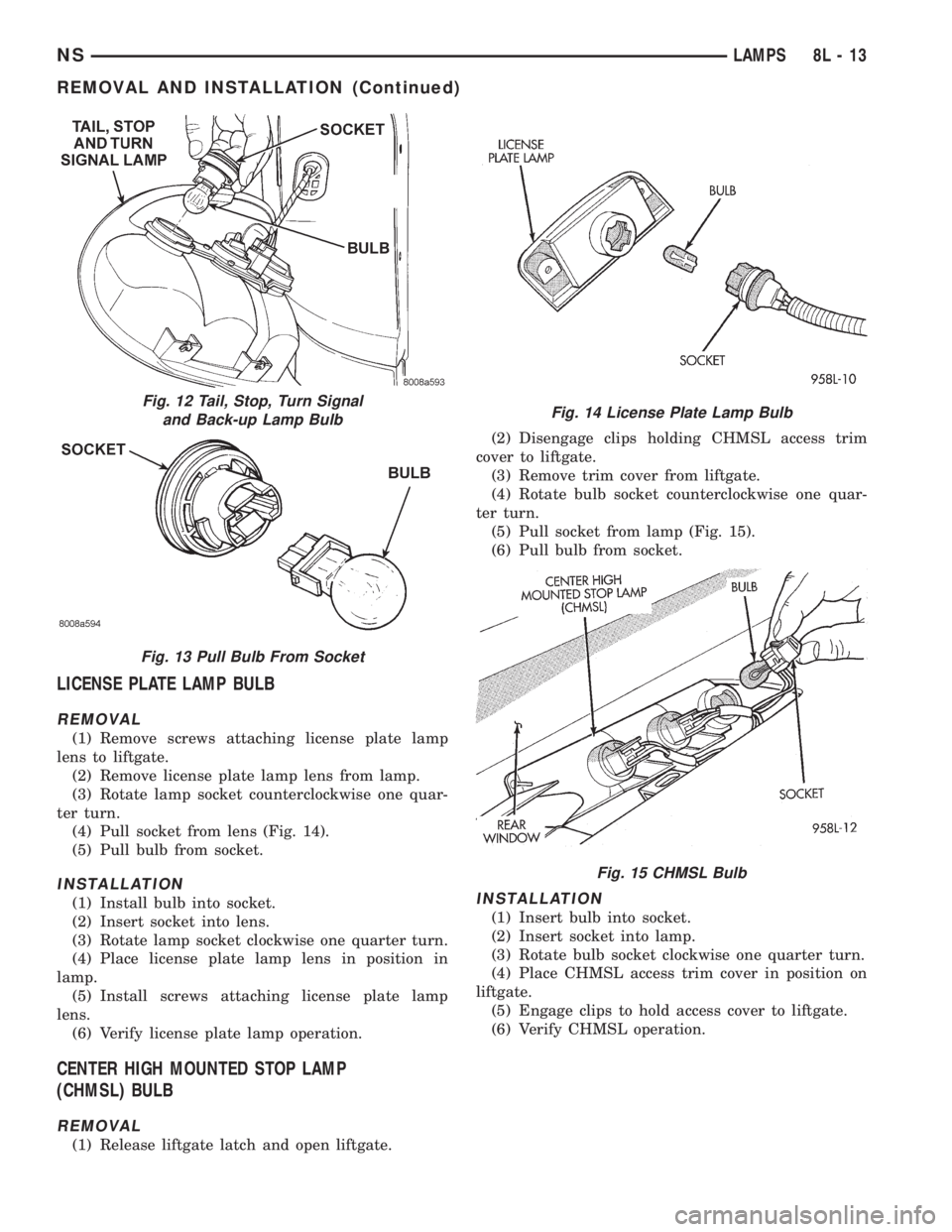
LICENSE PLATE LAMP BULB
REMOVAL
(1) Remove screws attaching license plate lamp
lens to liftgate.
(2) Remove license plate lamp lens from lamp.
(3) Rotate lamp socket counterclockwise one quar-
ter turn.
(4) Pull socket from lens (Fig. 14).
(5) Pull bulb from socket.
INSTALLATION
(1) Install bulb into socket.
(2) Insert socket into lens.
(3) Rotate lamp socket clockwise one quarter turn.
(4) Place license plate lamp lens in position in
lamp.
(5) Install screws attaching license plate lamp
lens.
(6) Verify license plate lamp operation.
CENTER HIGH MOUNTED STOP LAMP
(CHMSL) BULB
REMOVAL
(1) Release liftgate latch and open liftgate.(2) Disengage clips holding CHMSL access trim
cover to liftgate.
(3) Remove trim cover from liftgate.
(4) Rotate bulb socket counterclockwise one quar-
ter turn.
(5) Pull socket from lamp (Fig. 15).
(6) Pull bulb from socket.
INSTALLATION
(1) Insert bulb into socket.
(2) Insert socket into lamp.
(3) Rotate bulb socket clockwise one quarter turn.
(4) Place CHMSL access trim cover in position on
liftgate.
(5) Engage clips to hold access cover to liftgate.
(6) Verify CHMSL operation.
Fig. 12 Tail, Stop, Turn Signal
and Back-up Lamp Bulb
Fig. 13 Pull Bulb From Socket
Fig. 14 License Plate Lamp Bulb
Fig. 15 CHMSL Bulb
NSLAMPS 8L - 13
REMOVAL AND INSTALLATION (Continued)
Page 466 of 1938
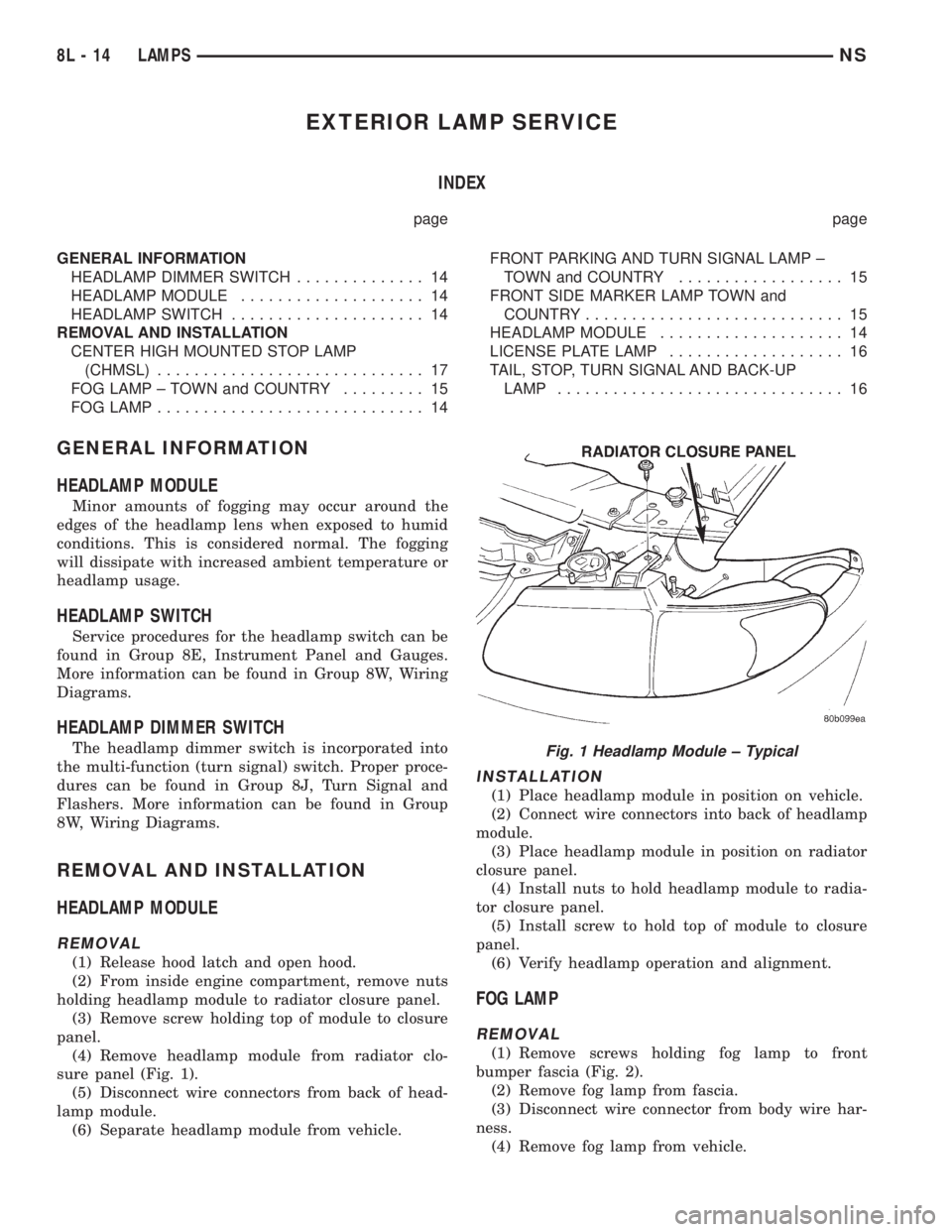
EXTERIOR LAMP SERVICE
INDEX
page page
GENERAL INFORMATION
HEADLAMP DIMMER SWITCH.............. 14
HEADLAMP MODULE.................... 14
HEADLAMP SWITCH..................... 14
REMOVAL AND INSTALLATION
CENTER HIGH MOUNTED STOP LAMP
(CHMSL)............................. 17
FOG LAMP ± TOWN and COUNTRY......... 15
FOG LAMP............................. 14FRONT PARKING AND TURN SIGNAL LAMP ±
TOWN and COUNTRY.................. 15
FRONT SIDE MARKER LAMP TOWN and
COUNTRY............................ 15
HEADLAMP MODULE.................... 14
LICENSE PLATE LAMP................... 16
TAIL, STOP, TURN SIGNAL AND BACK-UP
LAMP............................... 16
GENERAL INFORMATION
HEADLAMP MODULE
Minor amounts of fogging may occur around the
edges of the headlamp lens when exposed to humid
conditions. This is considered normal. The fogging
will dissipate with increased ambient temperature or
headlamp usage.
HEADLAMP SWITCH
Service procedures for the headlamp switch can be
found in Group 8E, Instrument Panel and Gauges.
More information can be found in Group 8W, Wiring
Diagrams.
HEADLAMP DIMMER SWITCH
The headlamp dimmer switch is incorporated into
the multi-function (turn signal) switch. Proper proce-
dures can be found in Group 8J, Turn Signal and
Flashers. More information can be found in Group
8W, Wiring Diagrams.
REMOVAL AND INSTALLATION
HEADLAMP MODULE
REMOVAL
(1) Release hood latch and open hood.
(2) From inside engine compartment, remove nuts
holding headlamp module to radiator closure panel.
(3) Remove screw holding top of module to closure
panel.
(4) Remove headlamp module from radiator clo-
sure panel (Fig. 1).
(5) Disconnect wire connectors from back of head-
lamp module.
(6) Separate headlamp module from vehicle.
INSTALLATION
(1) Place headlamp module in position on vehicle.
(2) Connect wire connectors into back of headlamp
module.
(3) Place headlamp module in position on radiator
closure panel.
(4) Install nuts to hold headlamp module to radia-
tor closure panel.
(5) Install screw to hold top of module to closure
panel.
(6) Verify headlamp operation and alignment.
FOG LAMP
REMOVAL
(1) Remove screws holding fog lamp to front
bumper fascia (Fig. 2).
(2) Remove fog lamp from fascia.
(3) Disconnect wire connector from body wire har-
ness.
(4) Remove fog lamp from vehicle.
Fig. 1 Headlamp Module ± Typical
8L - 14 LAMPSNS
Page 467 of 1938
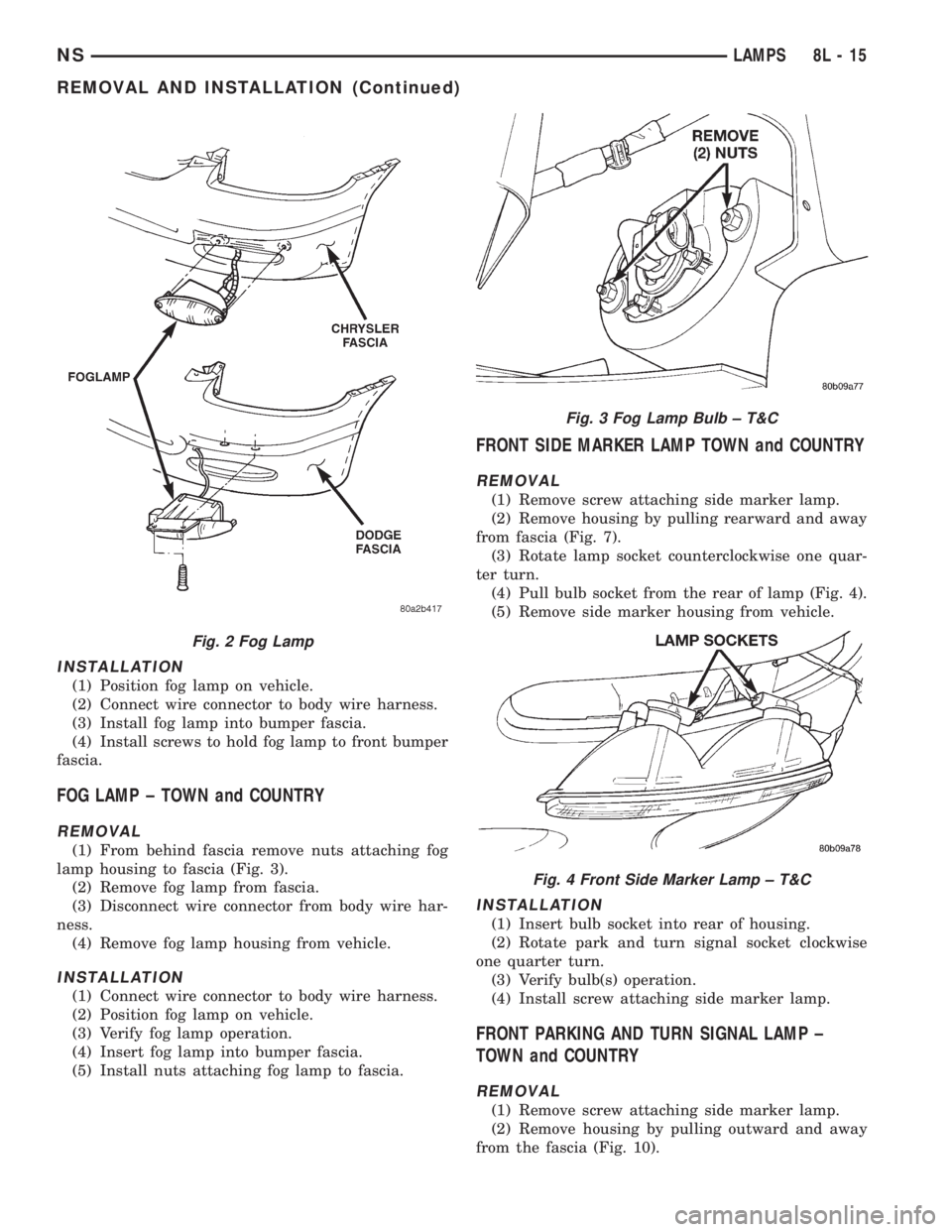
INSTALLATION
(1) Position fog lamp on vehicle.
(2) Connect wire connector to body wire harness.
(3) Install fog lamp into bumper fascia.
(4) Install screws to hold fog lamp to front bumper
fascia.
FOG LAMP ± TOWN and COUNTRY
REMOVAL
(1) From behind fascia remove nuts attaching fog
lamp housing to fascia (Fig. 3).
(2) Remove fog lamp from fascia.
(3) Disconnect wire connector from body wire har-
ness.
(4) Remove fog lamp housing from vehicle.
INSTALLATION
(1) Connect wire connector to body wire harness.
(2) Position fog lamp on vehicle.
(3) Verify fog lamp operation.
(4) Insert fog lamp into bumper fascia.
(5) Install nuts attaching fog lamp to fascia.
FRONT SIDE MARKER LAMP TOWN and COUNTRY
REMOVAL
(1) Remove screw attaching side marker lamp.
(2) Remove housing by pulling rearward and away
from fascia (Fig. 7).
(3) Rotate lamp socket counterclockwise one quar-
ter turn.
(4) Pull bulb socket from the rear of lamp (Fig. 4).
(5) Remove side marker housing from vehicle.
INSTALLATION
(1) Insert bulb socket into rear of housing.
(2) Rotate park and turn signal socket clockwise
one quarter turn.
(3) Verify bulb(s) operation.
(4) Install screw attaching side marker lamp.
FRONT PARKING AND TURN SIGNAL LAMP ±
TOWN and COUNTRY
REMOVAL
(1) Remove screw attaching side marker lamp.
(2) Remove housing by pulling outward and away
from the fascia (Fig. 10).
Fig. 2 Fog Lamp
Fig. 3 Fog Lamp Bulb ± T&C
Fig. 4 Front Side Marker Lamp ± T&C
NSLAMPS 8L - 15
REMOVAL AND INSTALLATION (Continued)